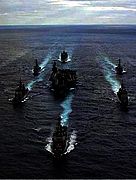Islamic Republic Retreats from Strategy of Threats
» Continuation of US Presence in the Persian Gulf
Soon after the threatening remarks by senior commanders of Iran’s armed forces about shutting the Strait of Hormuz, and attacking the US Navy ships should they return to the Persian Gulf, the strong US warning that was communicated to Tehran has forced Iranian military officials to retreat from pursuing their threats and announce that the addition of a new US warship to the existing fleet in the region was a routine matter.
Speaking to the country’s official IRNA news agency, the deputy commander of Iran’s Revolutionary Guards (IRGC) responded to the addition of a new US warship to the Persian Gulf region by saying, “American warships and its armed forces have for many years been present in the Persian Gulf and the Middle East regions, and based on this, their decision to send new warships is not a new issue and this must be interpreted in light of their continued presence.”
General Hossein Salami added, “Of course this presence came about because of insecurity and tensions in the security of the region and its impact is felt in the security conditions of the Middle East, Eastern Mediterranean and particularly countries such as Iraq and Afghanistan.”
Referring to the earlier-announced war games of IRGC’s navy, Salami said the exercises would take place in the Persian Gulf at the “agreed time.”
Earlier, IRGC General Ali Fadavi had announced that “large sea war-games of the IRGC, code named “Payambar Azam 7” will be held in parts of the Persian Gulf and the Strait of Hormuz during the month of Bahman (January 21 till February 29). Even though Fadavi did not specify the exact days of the war games, Basirat website – the official website of the political office of the IRGC – had said that they would take place in the latter part of Bahman (i.e., after February 4).
These remarks come as US Defense Secretary Leon Panetta announced that US aircraft carrier USS Enterprise would be returning to the Middle East next month and would position itself in the Persian Gulf after sailing through the Strait of Hormuz. He also stressed that currently there were two other US warships in the Persian Gulf and added that the Enterprise’s addition carries a “clear message” to the Islamic republic of Iran.
New Defense Strategy
US aircraft carrier USS John Stennis had left the Persian Gulf earlier during or prior to the naval war-games of the Iranian navy in the Persian Gulf – code named Velayat 90. At the time, General Ataollah Salehi, the commander of Iran’s armed forces make a threatening remark that the aircraft carrier should not return to the Persian Gulf, adding that “we are not used to repeating our warnings and only warn one time.”
Following that, other Iranian commanders, such as General Salehi, made similar remarks and said that if Iranian oil was embargoed by the EU, they would shut the Strait of Hormuz. Prior to this, Yadollah Javani, ayatollah Khamenei’s advisor in the IRGC had said that Khamenei had said Iran should “respond to a threat with a threat,” adding that this was the new defense strategy of the country. Speaking to officers of the army’s Imam Ali War College on November 10, 2011, ayatollah Khamenei said, “We are a nation that will respond to any threat with full force. We are not a nation to sit and watch hollow materialistic powers that are rotten from the inside threaten us: We shall threaten in response to threats.”
Even though Iranian leaders have declared their ability to shut the Strait, none have said anything about their ability to keep this strategic strait shut.


